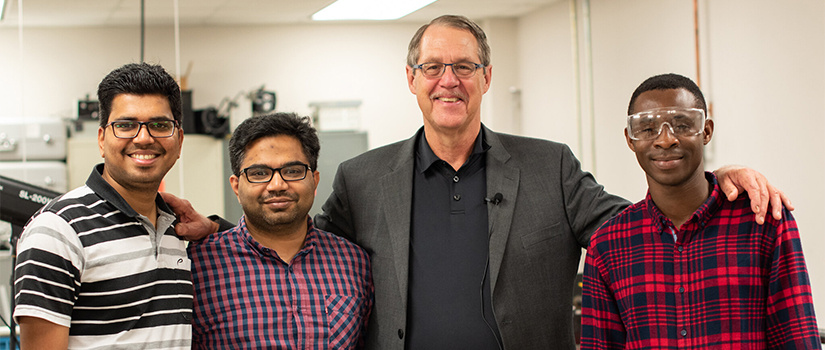Overview
The Center for Mechanics of Materials and Non-Destructive Evaluation (CMOMNDE) was established in 1983 at the University of South Carolina by the state of South Carolina. Recognizing the economic importance of materials and in-situ monitoring of critical components, the center is chartered to perform long-term research and development in mechanics of materials and NDE. The center facilitates productive interactions with industry, government agencies and university researchers.
Research Strengths
Digital Image Correlation (DIC) was pioneered and continues to be developed as a deformation and shape measurement technique by CMOMNDE researchers. DIC applies computer-vision techniques to measure full-field surface deformations by tracking the movement of a surface pattern during an experiment or application. A pair or series of surface pattern images are acquired during deformation and discretized into subsets. The maximum correlation between successive subsets determines the tensor of subset displacements. Full-field strains are computed with sub-pixel accuracy. DIC has been used successfully for characterizing viscoelastic biomaterials, determining stress intensity factors in cracked components with complex geometries, analyzing impact, and measuring deformations at high magnifications, at high temperatures and in aggressive environments.
Theoretical and advanced computational mechanics, coupled with experimental measurements, provide a powerful foundation to accurately predict the mechanical response of materials and components. CMOMNDE researchers employ a variety of commercial and custom software for finite element and other numerical analyses. Inverse analysis methods with finite element modeling can be applied to identify material parameter values for viscoelastic anisotropic constitutive models through matching simulation predictions with experimental measurements.
People
The center is directed by Michael Sutton, Distinguished Professor of Mechanical Engineering and Fellow of the National Academy of Engineering. Affiliated faculty and students have backgrounds in materials science, manufacturing processes, theoretical, computational and experimental mechanics and the application of computer vision techniques to experimental mechanics.
Selected Projects:
To measure the inhomogeneous 3D-strain fields present during inflation-extension testing of physiologically submerged micro-aneurysms, a Stereo Digital Image Correlation (StereoDIC) microscopy system is developed that revolves 15° stereo-angle cameras around a centrally-mounted target. Calibration is performed using submerged dot patterns and system accuracy verified using strain and deformation analyses for rigid body motions of speckle-patterned, micro-aneurysmal surrogates. In terms of the Green-Lagrange strain tensor and the 3D displacement fields, the results are stable even after 120 minutes, with maxima in both strain bias and strain standard deviation less than 2E-03 for all components, and micron-level displacement standard deviation.
StereoDIC is employed to quantify wrinkling on 6.35 mm wide and 0.16 mm thick carbon-epoxy tows during advanced fiber placement along straight and circular paths on a planar composite surface. Measurements obtained just after placement provide quantitative deformation fields, including the presence of out-of-plane wrinkles that occur during the placement process. Results show that wrinkles occur at locations where the substrate has defects. Results also show that wrinkles occur at other locations only when the radius of curvature is less than 2540 mm.
The very early stages of high rate tensile loading are important when attempting to characterize the response of materials during the transient loading time. To improve understanding of the conditions imposed on the specimen during the transient stage, a series of high rate loading experiments are performed using a Kolsky tensile bar system. Specimen forces and velocities during the high rate loading experiment are obtained by performing a thorough method of characteristics analysis of the system employed in the experiments. The in-situ full-field specimen displacements, velocities and accelerations during the loading process are quantified using modern ultra-high-speed imaging systems to provide detailed measurements of specimen response, with emphasis on the earliest stages of loading. Detailed analysis of the image-based measurements confirms that conditions are nominally consistent with those necessary for use of the one-dimensional wave equation within the relatively thin, dog-bone shaped tensile specimen.
Specifically, measurements and use of the one-dimensional wave equation show clearly that the specimen has low inertial stresses in comparison to the applied transmitted force. Though the accelerations of the specimen continue for up to 50 μs, measurements show that the specimen is essentially in force equilibrium beginning a few microseconds after initial loading. These local measurements contrast with predictions based on comparison of the wave-based incident force measurements, which suggest that equilibrium occurs much later, on the order of 40–50 μs.
